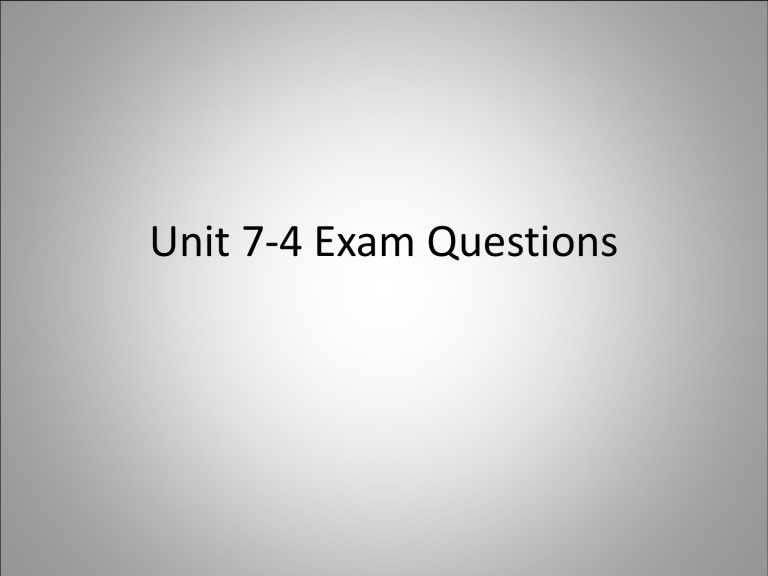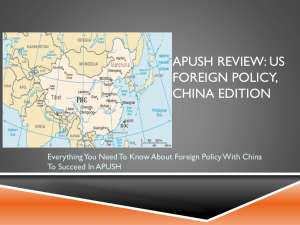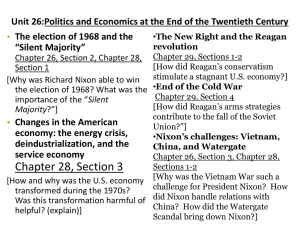modern era practice questions - Wayne County School District

Unit 7-4 Exam Questions
Directions
1. Click the indicated icon to begin the slide show
2. Press the right arrow key on the keyboard once to reveal the answer
3. Press the right arrow key once more to advance to the next question
Table of Contents
Regents of the University of California v. Bakke
26th Amendment
The ratification of the 26th amendment, which lowered the voting age to 18, was a result of the
(1) participation of the United States in the
Vietnam War
(2) fear of McCarthyism
(3) reaction to the launching of Sputnik by the
Soviet Union
(4) reporting of the Watergate scandal
Title IX
The data included in the table suggest that since 1971
(1) boys are losing interest in participating in sports
(2) participation in sports by boys and girls is nearly equal
(3) girls’ participation in sports equals that of boys
(4) girls’ participation in sports is increasing at a faster rate than that of boys
Title IX
Which development contributed most to the changes shown in the table?
(1) passage of the Civil Rights Act of 1964
(2) inclusion of Title IX in the Education Amendments of 1972
(3) the beginning of Head Start programs in the 1960s
(4) increase in the number of nonpublic schools since the 1970s
Title IX
“No person in the United States shall, on the basis of sex, be excluded from participation in, be denied the benefits of, or be subjected to discrimination under any education program or activity receiving Federal financial assistance, . . .”
— Title IX, 1972
The passage of this law affected women across the nation by
(1) granting them the right to own property
(2) guaranteeing them the same wages as male workers
(3) increasing their opportunities to participate in school sports
(4) allowing them the right to seek elective offices
Title IX
The Equal Pay Act, the Title IX education amendment, and the proposed Equal Rights amendment (ERA) were primarily efforts to improve the status of
(1) African Americans
(2) Native American Indians
(3) migrant workers
(4) women
Strategic Arms Limitation Treaty
(SALT)
The Strategic Arms Limitation Treaty (SALT), signed by President Richard Nixon with the
Soviet Union, was an effort to advance the foreign policy of
(1) détente
(2) imperialism
(3) brinkmanship
(4) globalization
Strategic Arms Limitation Treaty
(SALT)
Which United States foreign policy decision most clearly reflects the relationship shown in the cartoon?
(1) issuance of the
Eisenhower Doctrine
(2) quarantine of Cuba
(3) support of Israel in the
Six Day War
(4) negotiation of the
Strategic Arms Limitation
Treaty (SALT)
Détente
President Richard Nixon’s policy of détente is best characterized by his
(1) decision to dismantle the nuclear weapons arsenal of the United States
(2) attempt to reduce tensions with the Soviet
Union
(3) order to bomb Cambodia
(4) support for membership in the United Nations for communist countries
Détente
The policy of détente was used by President
Richard Nixon in an effort to
(1) decrease tensions between the Soviet Union and the United States
(2) improve relations with Latin America
(3) promote democratic government in China
(4) create stronger ties with Western Europe
Détente
The Strategic Arms Limitation Treaty (SALT), signed by President Richard Nixon with the
Soviet Union, was an effort to advance the foreign policy of
(1) détente
(2) imperialism
(3) brinkmanship
(4) globalization
Détente
A main goal of President Richard Nixon’s policy of détente was to
(1) sponsor free elections in North and South
Korea
(2) reduce tensions between the United States and the Soviet Union
(3) negotiate an end to the Arab-Israeli conflict
(4) build support for recognition of the
Nationalist government of Taiwan
Détente
The policy of détente pursued by President
Richard Nixon was an effort to
(1) increase foreign aid to African nations
(2) maintain access to East Asian markets
(3) reduce conflict with the Soviet Union
(4) end trade barriers among Western Hemisphere nations
Détente
The United States policy of détente can best be described as an effort to
(1) reduce tensions with the Soviet Union
(2) negotiate peace agreements with North
Korea
(3) halt the arms race with China
(4) end an embargo against Cuba
Détente
President Richard Nixon’s foreign policy of détente was an attempt to
(1) resolve Middle East conflicts
(2) improve relations with the Soviet Union
(3) defend United States interests in Latin
America
(4) increase the power of the United Nations
Security Council
Détente
The cartoonist is commenting on which
Cold War foreign policy?
(1) détente
(2) brinkmanship
(3) the domino theory
(4) collective security
Détente
The primary purpose of President Richard Nixon’s policy of détente was to
(1) expand United States military involvement in
Southeast Asia
(2) assure an adequate supply of oil from the
Middle East
(3) ease tensions between the United States and the Soviet Union
(4) maintain a favorable balance of trade with China
Détente
Which term is most commonly used to describe
President Richard Nixon’s foreign policy toward the Soviet Union?
(1) collective security
(2) brinkmanship
(3) détente
(4) neutrality
Détente
The main goal of President Richard Nixon’s foreign policy of détente was to
(1) assure American victory in Vietnam
(2) resolve conflicts in the Middle East
(3) abolish the North Atlantic Treaty
Organization
(NATO)
(4) improve relations with the Soviet Union
Watergate
The terms Teapot Dome, Watergate, and Iran-
Contra are most closely associated with
(1) domestic policies
(2) presidential scandals
(3) federal court decisions
(4) failed reform movements
Watergate
Which event led to this letter being written?
(1) Teapot Dome scandal
(2) Kent State shootings
(3) Iran-Contra affair
(4) Watergate break-in
Watergate
President Richard Nixon’s decision to resign from the presidency in 1974 was based primarily on
(1) developments in the Watergate investigation
(2) backlash from his policies toward China and the Soviet Union
(3) protests against his secret military actions during the Vietnam War
(4) accusations of trading arms for hostages
Watergate
Which action did President Gerald Ford take in an attempt to end the national controversy over the Watergate affair?
(1) pardoning Richard Nixon
(2) declaring a war on poverty
(3) declining to run for reelection
(4) asking Congress to impeach Richard Nixon
Watergate
The cartoon is most closely associated with the controversy over the
(1) Watergate affair
(2) war on drugs
(3) Arab-Israeli conflict
(4) Iran hostage crisis
Watergate
A major effect of the Watergate scandal of the
1970s was that it
(1) led to the Arab oil embargo
(2) reduced people’s trust in government
(3) resulted in term limits for elected officials
(4) increased presidential power
Watergate
The conflict that was the focus of the cartoon involved
President Richard Nixon’s attempt to
(1) increase the number of troops in Vietnam
(2) withhold evidence in the
Watergate scandal
(3) impose mandatory wage and price controls
(4) improve relations with the
People’s Republic of China
Watergate
The cartoon illustrates the constitutional principle of
(1) federalism
(2) checks and balances
(3) representative government
(4) civilian control of the military
Watergate
Which statement best describes an impact of the
Watergate scandal on American society?
(1) The modern environmental movement began.
(2) Public trust in government declined.
(3) Voter turnout in elections increased.
(4) An economic recession ended.
United States v. Nixon (1974)
The Supreme Court decisions in New York Times
Co. v. United States (1971) and United States v.
Nixon (1974) reinforced the principle that the president of the United States
(1) has unlimited use of the veto power
(2) is protected from unfair media criticism
(3) may not be convicted of a crime
(4) is not above the law
United States v. Nixon (1974)
The Supreme Court ruling in United States v.
Nixon (1974) was significant because it directly
(1) increased the power of the legislative branch
(2) showed that the Court controlled the executive branch
(3) limited the president’s power of executive privilege
(4) weakened the principle of federalism
United States v. Nixon (1974)
The conflict that was the focus of the cartoon involved
President Richard Nixon’s attempt to
(1) increase the number of troops in Vietnam
(2) withhold evidence in the
Watergate scandal
(3) impose mandatory wage and price controls
(4) improve relations with the
People’s Republic of China
United States v. Nixon (1974)
The cartoon illustrates the constitutional principle of
(1) federalism
(2) checks and balances
(3) representative government
(4) civilian control of the military
The Pentagon Papers
So far this term has appeared only as a wrong answer choice in the multiple choice portion of the exam.
The Pentagon Papers: Papers that contain a history of the
U.S. role in Indochina (includes Vietnam) from World War
II until May 1968 and that were commissioned in 1967 by
U.S. Secretary of Defense Robert S. McNamara. They were turned over (without authorization) to The New
York Times by Daniel Ellsberg, a senior research associate at the Massachusetts Institute of Technology’s Center for
International Studies.
Three Mile Island
So far this term has not shown up on the multiple choice of an exam.
Three Mile Island: a partial nuclear meltdown which occurred in one of the two Three Mile Island nuclear reactors in Dauphin County, Pennsylvania,
United States, on March 28, 1979. It was the worst accident in U.S. commercial nuclear power plant history.[1] The incident was rated a five on the seven-point International Nuclear Event Scale:
Accident With Wider Consequences.
Camp David Accords
Which foreign policy agreement had the most direct influence on the Middle East?
(1) Kellogg-Briand Pact
(2) Yalta Conference declaration
(3) SALT I Treaty
(4) Camp David Accords
Camp David Accords
Which action was a major foreign policy achievement of President Jimmy Carter?
(1) settling the Suez crisis
(2) withdrawing the United States from the
Vietnam War
(3) establishing improved relations with Iran
(4) mediating the Camp David Accords between
Egypt and Israel
Camp David Accords
“President Wilson Represents the United States at
Versailles”
“President Reagan Meets with Soviet President
Gorbachev”
“President Carter Negotiates Camp David Accords”
Each headline illustrates a time when the president of the
United States acted as
(1) chief diplomat
(2) chief legislator
(3) commander in chief
(4) head of a political party
Camp David Accords
The Camp David Accords negotiated by
President Jimmy Carter were important because they
(1) reduced tensions in the Middle East
(2) renewed diplomatic relations between the
United States and China
(3) slowed the pace of the nuclear arms race
(4) provided for cooperation with the Soviet
Union in the exploration of outer space
Camp David Accords
In the Camp David Accords (1978), President
Jimmy Carter succeeded in
(1) returning the Panama Canal Zone to Panama
(2) suspending grain sales to the Soviet Union and China
(3) providing a foundation for a peace treaty between Egypt and Israel
(4) freeing hostages being held in Iran
Camp David Accords
The Camp David Accords and the Persian Gulf
War both show the desire of the United States to
(1) create stability in the Middle East
(2) expand trade with Asian nations
(3) maintain friendly relations with Europe
(4) provide economic stability in Latin America
Iran Hostage Crisis
So far this term has only appeared as an incorrect answer choice in the multiple choice section of the exam.
(
Iran Hostage Crisis: The Iran hostage crisis, referred to in Persian as هنلا ریخست
اکیرما یسوساج literally "Conquest of the American Spy Den,"), was a diplomatic crisis between Iran and the United States. Fifty-two American diplomats and citizens were held hostage for 444 days (November 4, 1979, to
January 20, 1981), after a group of Iranian students supporting the Iranian
Revolution took over the US Embassy in Tehran. President Carter called the hostages "victims of terrorism and anarchy," adding that "the United States will not yield to blackmail.“
The crisis was described by the western media as an entanglement of
"vengeance and mutual incomprehension." In Iran, the hostage taking was widely seen as a blow against the United States and its influence in Iran, its perceived attempts to undermine the Iranian Revolution, and its longstanding support of the recently overthrown Shah of Iran, Mohammad Reza Pahlavi.
Energy Crisis
“. . . Our decision about energy will test the character of the
American people and the ability of the President and the
Congress to govern. This difficult effort will be the ‘moral equivalent of war’— except that we will be uniting our efforts to build and not destroy. . . .”
— President Jimmy Carter Address to the Nation, April 18,
1977
President Carter put these ideas into practice by
(1) halting construction of nuclear power plants
(2) increasing imports of foreign oil
(3) urging the development of alternative fuel sources
(4) imposing a price freeze on all petroleum products
Energy Crisis
Which situation in the 1970s caused the United
States to reconsider its dependence on foreign energy resources?
(1) war in Afghanistan
(2) oil embargo by the Organization of
Petroleum Exporting Countries (OPEC)
(3) meetings with the Soviet Union to limit nuclear weapons
(4) free-trade agreements with Canada and
Mexico
Oil Embargo
Which situation in the 1970s caused the United
States to reconsider its dependence on foreign energy resources?
(1) war in Afghanistan
(2) oil embargo by the Organization of
Petroleum Exporting Countries (OPEC)
(3) meetings with the Soviet Union to limit nuclear weapons
(4) free-trade agreements with Canada and
Mexico
New Federalism
So far this term has not appeared in a multiple choice question.
New Federalism: Refers to the return of powers to the states that had been taken by the federal government during President Franklin D.
Roosevelt’s New Deal.
Reaganomics /
Supply Side Economics
President Ronald Reagan used the concept of supply-side economics when he proposed
(1) reducing income taxes to stimulate growth
(2) providing direct payments to people living in poverty
(3) creating government jobs to keep people working
(4) increasing regulations on business to promote competition
Reaganomics /
Supply Side Economics
President Ronald Reagan’s supply-side economic policy was successful in
(1) increasing government spending on social programs
(2) lowering tax rates on personal and business income
(3) reducing defense spending
(4) enforcing stricter environmental regulations
Reaganomics /
Supply Side Economics
Which heading best completes the partial outline below?
(1) Social Reforms
(2) Constitutional Amendments
(3) Economic Policies
(4) Religious Beliefs
Star Wars
So far this term has not appeared in the multiple choice potion of an exam.
Star Wars: This term refers to President Ronald
Reagan’s Strategic Defense Initiative (SDI). This was a plan to use ground based and space based systems to protect the United States from attack by strategic nuclear ballistic missiles. The plan was criticized as unrealistic and unscientific and the idea was eventually scrapped.
Tinker v. Des Moines (1969)
Which category most accurately completes the heading for the partial outline below?
(1) Right to Counsel
(2) Student Rights
(3) School Integration
(4) Federal Funding of Education
Tinker v. Des Moines (1969)
The decisions of the United States Supreme
Court in Tinker v. Des Moines and New York
Times Co. v. United States were based on interpretations of the
(1) meaning of a republican form of government
(2) powers delegated specifically to Congress
(3) president’s right to executive privilege
(4) rights guaranteed by the 1st amendment
Tinker v. Des Moines (1969)
In the Supreme Court cases New Jersey v. T.L.O.
and Tinker v. Des Moines School District, the
Court ruled that
(1) individual student rights are more important than a safe school environment
(2) students can be expelled from school without a hearing
(3) civil liberties can be both protected and limited in schools
(4) the Bill of Rights does not apply to minors
New Jersey v. T.L.O. (1985)
Which category most accurately completes the heading for the partial outline below?
(1) Right to Counsel
(2) Student Rights
(3) School Integration
(4) Federal Funding of Education
New Jersey v. T.L.O. (1985)
The Supreme Court decisions in New Jersey v.
T.L.O. (1985) and Vernonia School District v.
Acton (1995) show that
(1) a student’s right to privacy is limited under certain conditions
(2) prayer in public schools must be limited
(3) racially segregated schools are unconstitutional
(4) a student has no guaranteed rights while in school
New Jersey v. T.L.O. (1985)
In the Supreme Court cases New Jersey v. T.L.O.
and Tinker v. Des Moines School District, the
Court ruled that
(1) individual student rights are more important than a safe school environment
(2) students can be expelled from school without a hearing
(3) civil liberties can be both protected and limited in schools
(4) the Bill of Rights does not apply to minors
Affirmative Action
The program that promotes preference in hiring for African Americans and other minorities to correct past injustices is known as
(1) Title IX
(2) open admissions
(3) affirmative action
(4) Head Start
Regents of the University of California v. Bakke (1978)
So far this term has not appeared in a multiple choice question.
Regents of the University of California v. Bakke (1978): a landmark decision by the Supreme Court of the United
States. It upheld affirmative action, allowing race to be one of several factors in college admission policy.
However, the court ruled that specific quotas, such as the
16 out of 100 seats set aside for minority students by the
University of California, Davis School of Medicine, were impermissible.
Sunbelt
So far this term has not appeared in a multiple choice question.
Sunbelt: a region of the United States generally considered to stretch across the South and
Southwest (the geographic southern United States).
Another rough boundary of the region is the area south of the 36th parallel, north latitude. The main defining feature of the Sun Belt is its warm climate with extended summers and brief, relatively mild winters.






